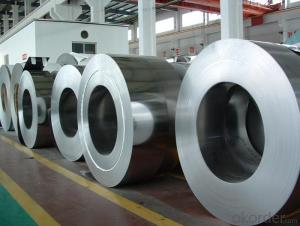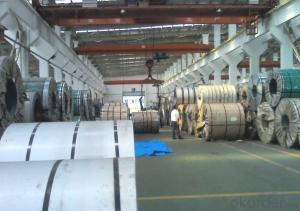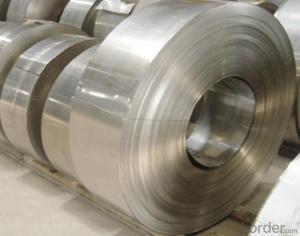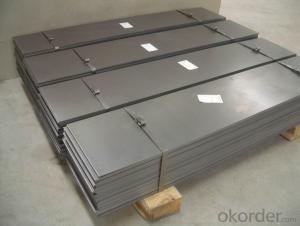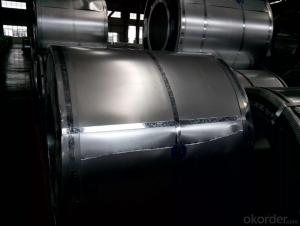Cold Rolled Steel Strip Stainless Steel Strip Coils
- Loading Port:
- China main port
- Payment Terms:
- TT or LC
- Min Order Qty:
- 100 m.t.
- Supply Capability:
- 100000000 m.t./month
OKorder Service Pledge
OKorder Financial Service
You Might Also Like
Packaging & Delivery
| Packaging Detail: | cold rolled stainless steel strip coils is packed in export standard package |
| Delivery Detail: | cold rolled stainless steel strip coils finished within 15 days |
Specifications
1,cold rolled stainless steel strip coils thickness0.2~1.5mm
2.Ensure you quality timely deliver
3.2B finish
4.Tolerance 0.01
Item Details:
1, cold rolled stainless steel strip coils with thickness 0.2~1.5mm
2, Finishing: 2B
3, Width: 15~500mm
4. Tolerance: -0.01mm~0.01mm
Our advantage
1, High quality: Using lastest automated control equipment to ensure china stainless steel coil quality, such as AGC system.
2, Best Price: With most automated equipments to cost down.
3, Fast delivery: Since your order placed, ETD will be only 10 days.
4, Best Sevice: We do believe your encouragement is the best support for us.
Shipping information:
1, Payment terms: T/T 30% for depsoit, Balance against the copy of B/L; or L/C at sight
2, ETD: 10-15 days after the receipt of the deposit
3, Ship terms: FOB Ningbo
4, Minimum quantity: 5 tons
Contact and Feedback:
If you are interested in any of cold rolled stainless steel strip coils or any question, please feel free to contact us. We will reply you within 24H.
- Q:How are steel strips inspected for dimensional accuracy?
- Steel strips are inspected for dimensional accuracy using various techniques such as laser measurement, optical inspection systems, and manual measurements. These methods ensure that the width, thickness, and length of the steel strips meet the specified tolerances and standards.
- Q:Can steel strips be coated or plated?
- Indeed, it is possible to coat or plate steel strips. Coating or plating steel strips is a prevalent procedure utilized in diverse industries to augment their effectiveness and safeguard them against corrosion. Multiple techniques exist for coating or plating steel strips, including hot-dip galvanization, electroplating, and powder coating. Each method confers distinct advantages and is selected based on the particular demands of the application. Coating or plating steel strips can enhance their visual appeal, longevity, and ability to withstand environmental elements, rendering them appropriate for a broad array of applications in construction, automotive, electronics, and numerous other industries.
- Q:How are steel strips leveled or straightened?
- Steel strips are typically leveled or straightened through a process called leveling or flattening. This involves passing the strips through a series of rolls that apply pressure and tension to remove any deformations and ensure their flatness.
- Q:Can steel strips be used in the production of shipping containers?
- Yes, steel strips can be used in the production of shipping containers. Steel strips are commonly used in the construction of shipping containers due to their strength, durability, and resistance to corrosion. They provide structural support and help maintain the container's shape and integrity during transportation and handling.
- Q:How do steel strips perform in welding and joining processes?
- Steel strips perform well in welding and joining processes due to their high strength and compatibility with various welding techniques. They can be easily joined to other steel components using methods such as arc welding, spot welding, and laser welding. The homogeneous composition and consistent thickness of steel strips ensure a strong and reliable bond, making them a preferred choice for many welding applications.
- Q:What are the common surface defects in steel strips?
- Steel strips commonly have surface defects, including scratches, scale, rust, roll marks, stretcher strains, surface roughness, edge cracks, and slivers. Scratches are visible marks or grooves caused by abrasive materials or mishandling. Scale is a thin layer of iron oxide formed during hot rolling, affecting appearance and quality. Rust occurs due to oxidation in humid or corrosive environments or inadequate storage. Roll marks are imperfections from the rolling process, affecting appearance and performance. Stretcher strains result from excessive stretching, causing deformations. Surface roughness varies due to uneven rolling or inadequate finishing. Edge cracks occur from improper trimming, tension, or material properties. Slivers are thin pieces detaching during processing. Identifying and addressing these defects is crucial for ensuring steel strip quality and performance in various applications.
- Q:How are steel strips used in the fabrication of furniture?
- Steel strips are commonly used in the fabrication of furniture for various purposes. They are typically used as structural components to provide strength, stability, and support to the furniture pieces. Steel strips can be shaped and welded into frames, legs, or brackets, which serve as the skeleton of the furniture. These frames are often hidden or covered by other materials such as wood or upholstery, but they are crucial in ensuring the durability and longevity of the furniture. Moreover, steel strips can also be used for decorative purposes in furniture fabrication. They can be bent, twisted, or etched to create intricate designs or patterns, adding aesthetic appeal to the furniture. For instance, steel strips can be used to create decorative accents on the arms or backrests of chairs, or as a decorative trim on the edges of tables or cabinets. In addition, steel strips are commonly used in furniture with adjustable features. They can be utilized as mechanisms for reclining chairs, extendable dining tables, or adjustable shelves. By incorporating steel strips in these mechanisms, furniture designers can ensure smooth and reliable operation, as well as enhance the overall functionality of the furniture. Overall, steel strips play a vital role in the fabrication of furniture by providing structural support, decorative elements, and adjustable features. They contribute to the strength, durability, and aesthetic appeal of the furniture, making them an essential component in the manufacturing process.
- Q:How do steel strips contribute to fire resistance in various applications?
- Steel strips contribute to fire resistance in various applications by providing structural integrity and containment of fire. Steel is inherently resistant to fire due to its high melting point and low thermal conductivity. When used as strips or reinforcements, steel can enhance the fire resistance of different materials and structures. In construction, steel strips are often used in the form of fire-resistant coatings or as reinforcing elements in concrete structures. Fire-resistant coatings containing steel strips create a barrier that protects the underlying material from heat and flames. These coatings can delay the spread of fire, provide insulation, and prevent structural collapse. Steel strips also play a vital role in enhancing the fire resistance of concrete structures. When embedded within concrete, steel reinforcement bars or strips increase the strength and durability of the structure. In the event of a fire, the steel strips help maintain the structural integrity of the concrete, preventing it from crumbling or collapsing under high temperatures. Furthermore, steel strips are commonly used in fire doors and fire-rated partitions. These strips provide additional strength and stability to the doors and partitions, making them more resistant to fire and preventing the spread of flames and smoke. Steel strips in fire doors can also act as thermal barriers, reducing heat transfer and protecting the surrounding areas. In industrial applications, steel strips are utilized in the manufacturing of fire-resistant cables. These cables are designed to withstand high temperatures and maintain their functionality during fire emergencies. Steel strips within the cables provide mechanical strength and protection against heat, ensuring that critical electrical systems remain operational in fire-prone environments. In summary, steel strips contribute to fire resistance in various applications by providing structural support, containment, and insulation. Whether used in coatings, concrete reinforcement, fire doors, or fire-resistant cables, steel enhances the overall fire resistance of materials and structures, safeguarding lives and property in the event of a fire.
- Q:What are the common surface treatment methods for steel strips?
- There are several common surface treatment methods for steel strips, each serving specific purposes and providing various benefits. One widely used method is galvanizing, which involves coating the steel strip with a layer of zinc. This process helps protect the steel from corrosion, as the zinc acts as a sacrificial anode and prevents oxidation. Galvanized steel strips are commonly used in outdoor applications where they are exposed to moisture and harsh weather conditions. Another common surface treatment method is electroplating, which involves depositing a thin layer of metal onto the steel strip's surface through an electrochemical process. This method is often used to enhance the appearance of the steel strip, provide a decorative finish, or improve its resistance to corrosion. Phosphating is another surface treatment method used for steel strips. It involves the application of a phosphate coating to the steel surface, which helps improve its adhesion to paints, lubricants, or other coatings. Phosphating can also enhance the steel strip's corrosion resistance and provide better wear resistance. Coating steel strips with a layer of paint or other organic coatings is also a common surface treatment method. This process can protect the steel strip from corrosion, provide a decorative finish, or serve as a primer for subsequent coatings. Finally, shot blasting is a surface treatment method that involves propelling small abrasive particles at high speeds onto the steel strip's surface. This process helps remove rust, scale, or other contaminants, and prepares the steel strip for further treatment or coating. Overall, these surface treatment methods for steel strips aim to enhance their appearance, protect them from corrosion, improve their adhesion properties, and increase their durability for various applications.
- Q:How do steel strips perform in terms of chemical resistance?
- Steel strips generally have good chemical resistance due to the protective layer of oxide that forms on their surface. However, their resistance can vary depending on the specific type of steel and the chemicals involved.
1. Manufacturer Overview |
|
|---|---|
| Location | |
| Year Established | |
| Annual Output Value | |
| Main Markets | |
| Company Certifications | |
2. Manufacturer Certificates |
|
|---|---|
| a) Certification Name | |
| Range | |
| Reference | |
| Validity Period | |
3. Manufacturer Capability |
|
|---|---|
| a)Trade Capacity | |
| Nearest Port | |
| Export Percentage | |
| No.of Employees in Trade Department | |
| Language Spoken: | |
| b)Factory Information | |
| Factory Size: | |
| No. of Production Lines | |
| Contract Manufacturing | |
| Product Price Range | |
Send your message to us
Cold Rolled Steel Strip Stainless Steel Strip Coils
- Loading Port:
- China main port
- Payment Terms:
- TT or LC
- Min Order Qty:
- 100 m.t.
- Supply Capability:
- 100000000 m.t./month
OKorder Service Pledge
OKorder Financial Service
Similar products
New products
Hot products
Related keywords
